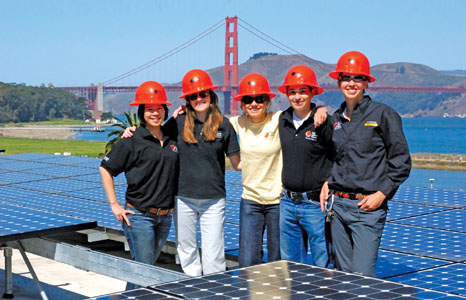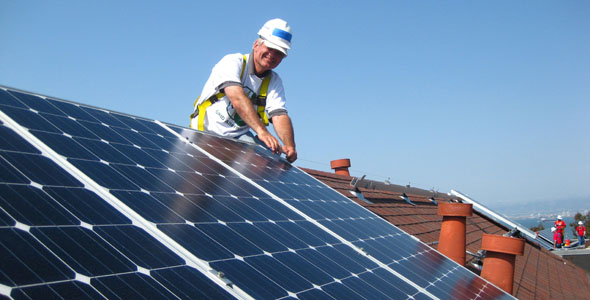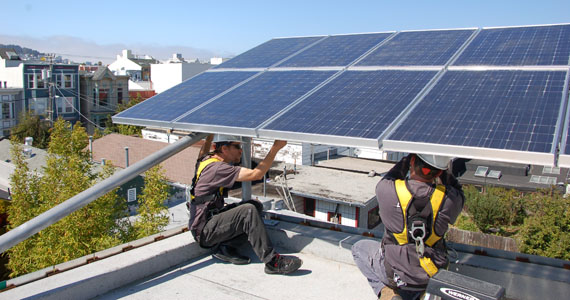San Franciscans, prepare to toot your City’s green horn yet again, for your hilly hamlet recently celebrated another impressive solar milestone.

Presidio Trust is the first solar project built in the historic Presidio district of San Francisco. This 50.3 kW DC system is designed to be virtually invisible from street level and provides power for the offices of the Presidio Trust. Notably, this system was designed and installed by an all-women team from Sun Light & Power. Photo courtesy of Sun Light & Power
By Bill Picture
Published: February, 2013
San Franciscans, prepare to toot your City’s green horn yet again, for your hilly hamlet recently celebrated another impressive solar milestone. With nearly 3,500 solar installations completed to date citywide, San Francisco now has more solar capacity than most states. In fact, were San Francisco itself a state, it could generate more clean energy than 29 others.
"For the most part, you can probably guess which states we’d beat out," said Renewable Energy Program Manager Danielle Murray, from the San Francisco Department of the Environment (SFDOE). "But there are a few that might surprise you that we don’t beat, like New Jersey. Some states have surprisingly strong renewable energy policies at the state level."
Assessing how San Francisco stacks up solar-wise against other municipalities is more difficult, according to Murray, because the City is pretty small geographically compared to, say, Los Angeles or New York, or even its neighbor San Jose. More land means more solar potential.
"So it depends on how you slice and dice the data that you’re looking at," she said. "But the bottom line is, we’re doing extremely well for a city of our size, and we’ve installed a lot of solar panels."
Conscience vs. Wallet
A "culture of sustainability" was cited in December by Murray’s boss, SFDOE Director Melanie Nutter, as being a factor in the growing number of solar projects, which have quintupled in the last five years.
Murray agrees that San Franciscans, and Bay Area residents in general, tend to be more tuned in to the idea of environmental stewardship—and she points to the vigilance with which they recycle and the growing number of hybrid vehicles on the road as proof. Nevertheless, she believes that the decision to go solar is driven more by finance than philosophy, and the wheels are greased by local, state and federal incentives.
"I think for the early adopters it was more about saving the environment," she said. "And as solar became more affordable, that’s where we saw the early growth. But now it just makes smart financial sense to go solar, particularly for homeowners in Tiers Three, Four and Five who are paying the higher electricity rates. That’s where we’re seeing real growth in the industry now. They’re looking at their bills and trying hard to find ways to save money, and increase the value of their property. Helping the environment is a bonus."
And it is a big bonus. Over 50 percent of the City’s greenhouse gas emissions come from generating the electricity needed to power buildings. The 27,350 megawatt hours produced by San Francisco solar panels each year, which is enough to power about 7,000 homes, keep more than 5,500 tons of carbon emissions from entering the atmosphere.
Another bonus is the impact that solar projects have on the local economy. To date, solar projects have pumped about $37 million into San Francisco’s economy, and have created more than 200 green jobs.
"It’s all about the green jobs right now," Murray said. "It’s just amazing the ripple effect that the decision to switch to solar has beyond your own home or business. It’s such a wise investment—for you and your community."
Keeping it going
Murray and her team are determined to keep the City’s solar momentum going. With single-family households securely onboard—3,294 of the 3,489 solar installations to date were residential—Murray plans to move on to multi-family buildings. "That’s the next frontier, so to speak," she said.
Until now, it hasn’t been possible for multi-unit buildings to use solar power for anything other than common-area electricity loads like hallways and elevators. But a new billing arrangement successfully piloted for use in the affordable housing sector will eventually allow landlords to parcel out the energy credits from a building’s solar system to the meters of individual tenants.
Murray is also keeping a close eye on efforts at the legislative level to make possible the creation of so-called "community solar gardens." These community-owned solar projects would allow several owners to buy in and share ownership of an off-site solar system. Each would own a piece of the system and get a share of its energy credits.
A bill to this effect, SB 834, was introduced last May by State Senator Lois Wolk of Davis. But PG&E, Southern California Edison and San Diego Gas & Electric, whose customers the bill would have allowed to participate in community solar programs, fought hard against the bill. By mid-September, SB 834 was dead on the Senate floor.
"But I don’t think that’s the end of it," Murray said. "It’s one of those ideas that is just too good to let die that easily."
Another program that Murray is excited about is CleanPowerSF, the City’s Community Choice Aggregation (CCA) Program. In the works for seven years, CleanPowerSF will give San Franciscans the power to choose between PG&E’s electricity, whose energy portfolio includes carbon-emitting and nuclear energy sources, and a 100 percent renewable energy portfolio. The way it will work is, beginning in October, entire sections of the City will automatically be enrolled in CleanPowerSF one-by-one. Should they decide they prefer to go back to PG&E, whose rates are cheaper, customers can opt out of the CleanPowerSF program. It’s important to note that PG&E will continue to handle billing and distribute electricity even for those customers who decide to remain with CleanPowerSF and pay the premium for green power.
"So if you’re really passionate about renewable energy but don’t have the ability to install panels where you live, this is an opportunity to put your money where you mouth is," Murray said.
"It’s an exciting time," Murray said, referring to the solar panels popping up on rooftops all across town. Make your way to any hilltop in the City and you’ll see what she means, quilt-like clusters of rooftop solar panels below you. "It makes me very happy," she said.
For more information on the San Francisco Department of the Environment’s Solar Program, visit www.sfenvironment.org/energy/renewable-energy/solar.

To date, nearly 3,500 solar projects have been completed in San Francisco. Were San Francisco a state, it could generate more clean energy than 29 other states. Photo courtesy of Grid Alternatives

The 27,350 megawatt hours generated in San Francisco each year keep more than 5,500 tons of carbon emissions from entering the atmosphere, have pumped about $37 million into the local economy, and have created more than 200 green jobs. Photo courtesy of Luminalt

